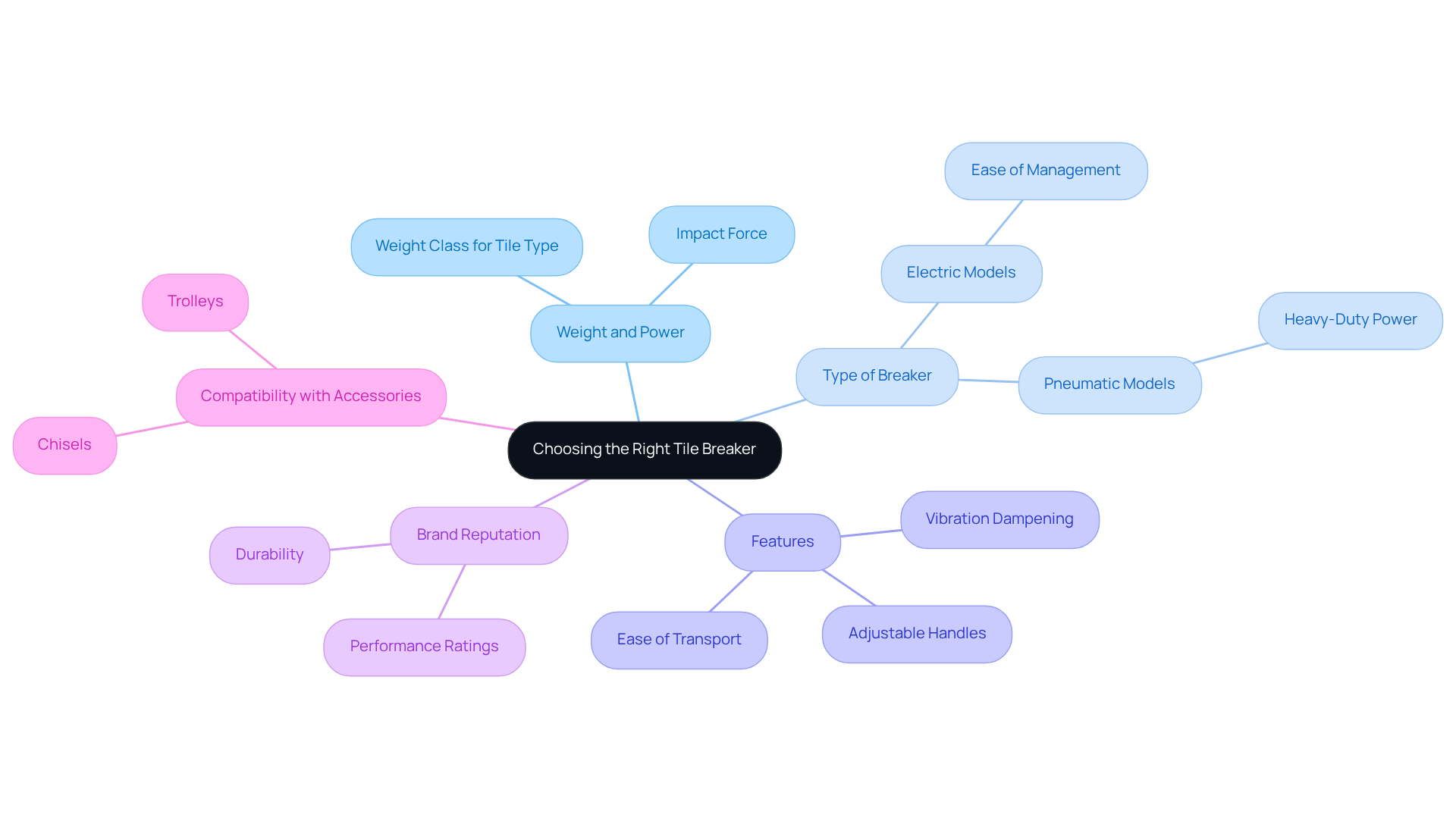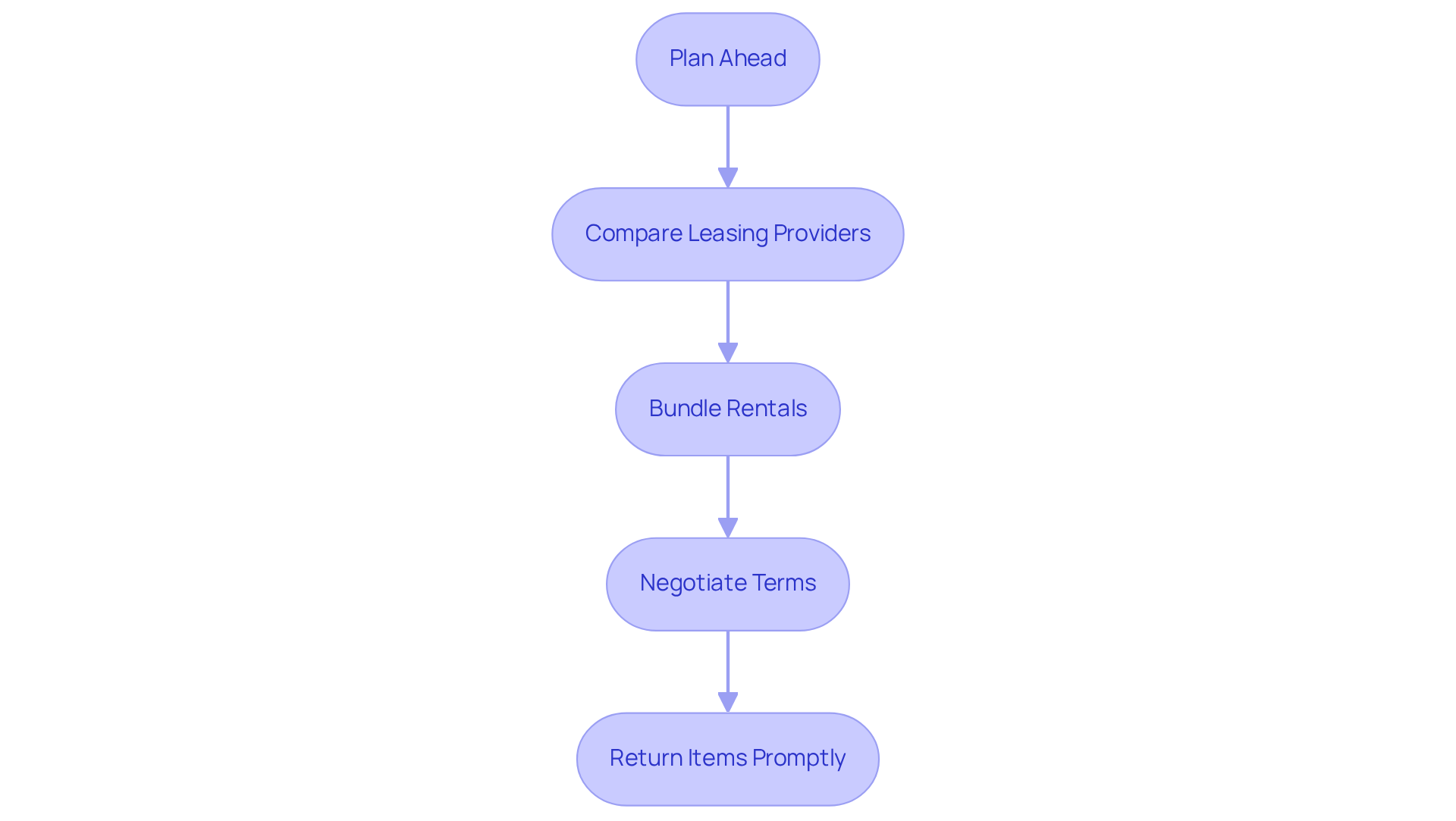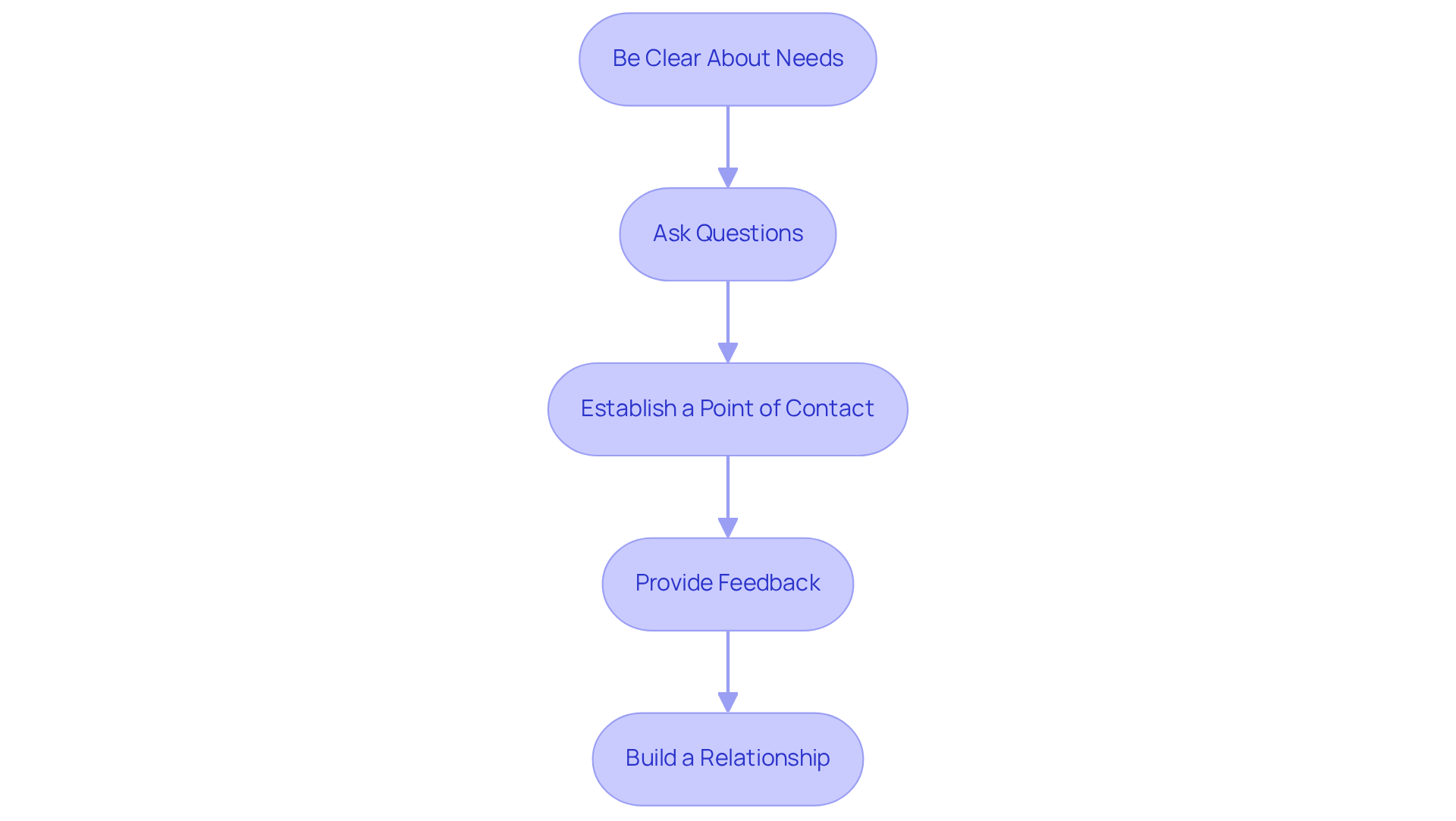Overview
The article outlines four key strategies for effective tile breaker rental. It emphasizes the importance of:
- Evaluating project scope
- Selecting the right equipment
- Planning rental duration
- Managing costs
Each strategy is supported by practical advice on assessing tile types, negotiating rental terms, and maintaining clear communication with providers. This ensures optimal performance and cost efficiency throughout the rental process.
Evaluating project scope is crucial. Understanding the specific requirements of your project allows for better equipment selection, which directly impacts efficiency. Furthermore, selecting the right equipment tailored to your needs can enhance the overall outcome of your project, ensuring that you achieve the desired results.
Planning the rental duration is equally important. By accurately estimating how long you will need the equipment, you can avoid unnecessary costs. In addition, managing costs effectively throughout the rental process is essential for maintaining budgetary constraints. This involves not only negotiating favorable rental terms but also being aware of any additional fees that may arise.
Ultimately, clear communication with rental providers is key. It fosters a collaborative relationship that can lead to better service and support during your rental period. By implementing these strategies, you can ensure a successful tile breaker rental experience, characterized by reliability and efficiency.
Key Highlights:
- Evaluate the project scope to determine the size and complexity of tile removal needed.
- Different tile types, such as ceramic or porcelain, require specific tile breakers for optimal performance.
- Consider rental duration; daily hires may suit short-term projects, while longer projects benefit from weekly or monthly agreements.
- Establish a budget that includes potential extra costs like delivery fees and insurance to avoid overspending.
- Request maintenance history of rental equipment to ensure reliability and performance.
- Choose between electric and pneumatic breakers based on project demands; heavier devices offer greater impact force.
- Look for essential features in tile breakers, such as adjustable handles and vibration dampening, for improved usability.
- Plan ahead to secure better rates and availability; 84% of U.S. construction firms prefer renting tools over buying.
- Compare multiple leasing providers to evaluate prices, terms, and equipment quality for cost efficiency.
- Inquire about bundle deals for multiple tools to lower overall expenses and simplify logistics.
- Negotiate leasing terms for longer durations to achieve better rates and savings.
- Ensure timely return of rented items to avoid late charges and maintain a positive relationship with providers.
- Clearly articulate project needs to rental providers for appropriate tool suggestions.
- Establish a primary contact for consistent communication with the leasing company to reduce misunderstandings.
- Provide feedback post-rental to help improve services and offerings from the rental provider.
Introduction
Navigating the world of tile breaker rentals can indeed be a daunting task, particularly for those who are not well-versed in the intricacies of construction equipment. With an abundance of options at one’s disposal, grasping the essential factors that influence rental decisions is vital for ensuring project success. This article explores four key strategies that not only streamline the rental process but also significantly enhance efficiency and cost-effectiveness. However, with numerous choices and potential pitfalls, how can one guarantee the selection of the right equipment and provider tailored to their specific project needs?
Understand Key Factors in Tile Breaker Rentals
When considering a tile breaker rental, several key factors must be taken into account to ensure an efficient and effective project outcome.
-
Project Scope: Start by evaluating the size and complexity of your tile removal project. Larger areas may necessitate more powerful tools to achieve optimal results.
-
Tile Type: Different tiles, such as ceramic or porcelain, require specific types of breakers. Understanding the material is crucial for selecting the appropriate tool that will perform at its best.
-
Rental Duration: Consider how long you will need the tools. For short-term projects, daily hires may be advantageous, while longer projects could benefit from weekly or monthly leasing agreements, which often provide better value.
-
Budget Constraints: Establish a clear financial plan for tool rental, factoring in potential extra expenses such as delivery fees and insurance. This careful planning will empower you to make informed decisions without overspending.
-
Maintenance History: Request information about the maintenance records of the machinery. A well-maintained tile cutter is essential for ensuring reliability and performance throughout the rental period. At EZ Equipment Rental, we prioritize the maintenance of our inventory, ensuring that all tools, including our tile breaker rental equipment, undergo regular inspections and cleaning. This commitment to maintenance not only enhances performance but also minimizes downtime, allowing contractors to focus on their projects. Furthermore, EZ Equipment Rental provides comprehensive support to address any issues promptly, reinforcing our dedication to exceptional customer service.
Choose the Right Tile Breaker for Your Project Needs
Choosing the right tile breaker rental is crucial for achieving optimal results in your projects. To make an informed decision, consider the following factors:
-
Weight and Power: Heavier devices typically deliver greater impact force, making them suitable for tougher materials. Assess the weight class necessary for your specific tile type to ensure effective performance.
-
Type of Breaker: You must decide between electric and pneumatic options. Electric models are often easier to manage, while pneumatic breakers may offer more power for heavy-duty tasks, catering to various project needs.
-
Features: Look for essential features such as adjustable handles, vibration dampening, and ease of transport. These enhancements significantly improve usability and comfort during operation, making your experience more efficient.
It is advisable to choose a tile breaker rental from reputable brands known for their durability and performance. Conduct thorough research on customer reviews and ratings to gauge the reliability of the equipment you choose.
- Compatibility with Accessories: Ensure that your selected breaker is compatible with necessary accessories, such as chisels and trolleys. This compatibility maximizes efficiency and enhances your overall workflow.
By carefully evaluating these factors, you can select the ideal tile breaker that meets your project's demands. Don't hesitate to reach out for expert advice or to explore our extensive range of equipment tailored to your needs.

Implement Cost-Effective Rental Strategies
To implement cost-effective rental strategies, consider the following:
-
Plan Ahead: Arranging leases in advance is crucial for securing better rates and ensuring availability. Last-minute bookings often lead to increased costs and restricted choices, which can affect project schedules and budgets. According to industry insights, 84% of construction firms in the U.S. prefer renting tools rather than buying, emphasizing the significance of planning ahead to take advantage of competitive pricing.
-
Compare Leasing Providers: Conduct thorough research on multiple leasing companies to evaluate prices, terms, and equipment quality. Look for promotions or discounts that may be available. As highlighted in the 'North America Construction Equipment Rental Trends' case study, the demand for leasing services surged due to increased construction activity, making it essential to compare options to maximize cost efficiency.
-
Bundle Rentals: When multiple tools are required, inquire about bundle deals that can lower overall expenses. Renting several items from the same provider not only simplifies logistics but can also lead to substantial discounts, maximizing your budget. This strategy aligns with the practices observed in successful leasing companies, as highlighted in the 'EZ Equipment Rental Overview.'
-
Negotiate Terms: Don’t hesitate to discuss leasing conditions, particularly for longer durations. Numerous providers are willing to provide improved rates for long-term agreements, which can result in considerable savings over time. Expert insights from industry leaders highlight the significance of customer feedback in shaping lease agreements, making negotiation a crucial strategy.
-
Return Items Promptly: Ensure timely return of items to avoid late charges. Acquainting yourself with the leasing agreement is crucial to comprehend the conditions concerning returns, aiding in sustaining a positive rapport with providers and preventing unforeseen expenses.
By applying these strategies, construction managers can enhance their equipment leasing procedures, ensuring both cost-effectiveness and efficiency.

Enhance Communication with Rental Providers
To enhance communication with rental providers, consider the following best practices:
-
Be Clear About Needs: Clearly articulate your project requirements, including the type of tile, project size, and timeline. This clarity allows providers to suggest the most appropriate tools for your specific needs.
-
Ask Questions: Don’t hesitate to inquire about device features, leasing terms, and maintenance history. A knowledgeable provider will appreciate your questions and offer valuable insights that can inform your decisions. At EZ Equipment Rental, our commitment to exceptional customer service ensures that you receive comprehensive support, addressing any concerns promptly to minimize downtime. We also provide detailed information regarding our maintenance procedures, ensuring that our tools are always in optimal condition for your projects.
-
Establish a Point of Contact: Designate a primary contact individual for communication with the leasing company. This practice ensures consistency and clarity in discussions, significantly reducing the chances of miscommunication.
-
Provide Feedback: After the leasing period, share your feedback regarding the equipment and service. This input assists leasing providers in enhancing their offerings and can lead to improved service in future agreements.
-
Build a Relationship: Foster a positive relationship with your rental provider. Regular communication and a good rapport can lead to better deals and priority service in future engagements.
Additionally, remember that effective communication is crucial; misunderstandings can lead to project delays. Avoid common pitfalls, such as making assumptions that can lead to misunderstandings.

Conclusion
Understanding the intricacies of tile breaker rentals is essential for achieving successful project outcomes. By carefully evaluating factors such as project scope, tile type, rental duration, budget constraints, and maintenance history, individuals can make informed decisions that lead to effective and efficient tile removal. Selecting the right equipment tailored to specific needs further enhances performance, ensuring that projects are completed smoothly and on time.
Key strategies for cost-effective rentals include:
- Planning ahead
- Comparing leasing providers
- Bundling rentals
- Negotiating terms
- Returning items promptly
These approaches not only help in managing costs but also streamline the rental process, allowing construction managers to focus on project execution rather than logistics. Furthermore, fostering clear communication with rental providers is vital in establishing strong working relationships, which can lead to better service and rates in the long run.
Ultimately, implementing these best practices in tile breaker rentals maximizes efficiency and contributes to overall project success. Embracing a proactive approach to equipment leasing empowers contractors to navigate the complexities of tile removal projects with confidence, ensuring they achieve desired results while staying within budget. Take the time to apply these insights and strategies, and elevate the effectiveness of your tile breaker rental experience.
Frequently Asked Questions
What factors should be considered when renting a tile breaker?
Key factors include project scope, tile type, rental duration, budget constraints, and maintenance history of the equipment.
How does the project scope affect tile breaker rental?
The size and complexity of the tile removal project determine the power and type of tools needed. Larger areas may require more powerful equipment for optimal results.
Why is tile type important in selecting a tile breaker?
Different tiles, such as ceramic or porcelain, require specific types of breakers to perform effectively. Understanding the material is crucial for selecting the appropriate tool.
How should I determine the rental duration for a tile breaker?
Consider the length of your project; daily rentals may be suitable for short-term needs, while longer projects might benefit from weekly or monthly rental agreements for better value.
What should I include in my budget for tile breaker rental?
Establish a clear financial plan that includes the rental cost and potential extra expenses such as delivery fees and insurance to avoid overspending.
Why is maintenance history important when renting a tile breaker?
A well-maintained tile cutter is essential for reliability and performance. Requesting maintenance records ensures that the equipment has been properly cared for and minimizes downtime.
How does EZ Equipment Rental ensure the quality of their tile breaker rentals?
EZ Equipment Rental prioritizes maintenance by conducting regular inspections and cleaning of their inventory, ensuring reliable performance and minimizing downtime. They also provide comprehensive support for any issues that may arise.




